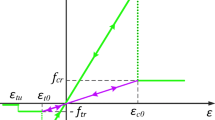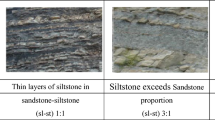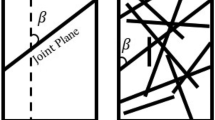Abstract
Rock anisotropy is an intrinsic property of natural rock mass, and layered rock has the most significant effect on the stress distribution and deformation of a rock mass. With the development of rock mechanics theory and constitutive theory, the study of rock anisotropy has become one of the focuses and hotspots in the field of rock mechanics. Based on the rock isotropic self-consistent theory, the rock anisotropy theory of different media such as triclinic anisotropy, monoclinic anisotropy, and orthorhombic anisotropy has been greatly developed. Rock mechanical property test, not only limited to the traditional single-axis, triaxial compression test, Brazilian split test and pure bending beam tensile test, and meso-structural characteristic test (XRD, ultrasonic test, etc.), is also widely used. With the development of numerical analysis theory and computer technology, numerical analysis methods such as finite difference method, discrete element method, finite element method, boundary element method, and interface element method have played an important role in the study of rock anisotropy characteristics. According to the assumptions and reasoning methods of anisotropic failure criterion, it can be classified into two categories: continuous failure criterion and discontinuous piecewise failure criterion. Continuous medium failure criterion can also be classified into mathematical and empirical ones. Because of the complexity of rock anisotropy, the research on yield criterion and constitutive relation of rock anisotropy is still in the stage of theoretical research, and it is seldom applied in actual rock engineering. The physics model of rock has an important influence on the study of the anisotropic characteristics of rock. Therefore, the establishment of an appropriate rock physics model has a direct impact on the accurate determination of rock anisotropy parameters and P-S wave velocity. Finally, the key and difficult points of anisotropic rock research and the direction of future research are discussed and analyzed to provide a reference for engineering practice and related problems.










Similar content being viewed by others
References
Ai C, Zhang J, Li YW, Zeng J, Yang XL, Wang JG (2016) Estimation criteria for rock brittleness based on energy analysis during the rupturing process. Rock Mech Rock Eng 49(12):4681–4698
Almqvist BS, Mainprice D (2017) Seismic properties and anisotropy of the continental crust: predictions based on mineral texture and rock microstructure. Rev Geophys 55(2):367–433
Angus DA, Fisher QJ, Segura JM, Verdon JP, Kendall JM, Dutko M, Crook AJL (2016) Reservoir stress path and induced seismic anisotropy: results from linking coupled fluid-flow/geomechanical simulation with seismic modelling. Pet Sci 13(4):669–684
Barton N, Quadros E (2015) Anisotropy is everywhere, to see, to measure, and to model. Rock Mech Rock Eng 48(4):1323–1339
Biedermann AR, Pettke T, Angel RJ, Hirt AM (2016) Anisotropy of magnetic susceptibility in alkali feldspar and plagioclase. Geophysical Supplements to the Monthly Notices of the Royal Astronomical Society 205(1):479–489
Bo X, Zhonghao W, Gongqiang L (2016) Based on rock electrical parameters anisotropy log evaluation method in horizontal well. J Comput Theor Nanosci 13(12):10281–10285
Bobet A (2016) Deep tunnel in transversely anisotropic rock with groundwater flow. Rock Mech Rock Eng 49(12):4817–4832
Brownlee SJ, Schulte-Pelkum V, Raju A, Mahan K, Condit C, Orlandini OF (2017) Characteristics of deep crustal seismic anisotropy from a compilation of rock elasticity tensors and their expression in s. Tectonics 36(9):1835–1857
Chan J, Schmitt DR (2015) Elastic anisotropy of a metamorphic rock sample of the Canadian shield in northeastern Alberta. Rock Mech Rock Eng 48(4):1369–1385
Chang L, Konietzky H, Frühwirt T (2019) Strength anisotropy of rock with crossing joints: results of physical and numerical modeling with gypsum models. Rock Mech Rock Eng:1–25
Chekhonin E, Popov E, Popov Y, Gabova A, Romushkevich R, Spasennykh M, Zagranovskaya D (2018) High-resolution evaluation of elastic properties and anisotropy of unconventional reservoir rocks via thermal core logging. Rock Mech Rock Eng 51(9):2747–2759
Chen SJ, Zhu WC, Yu QL, Liu XG (2016) Characterization of anisotropy of joint surface roughness and aperture by variogram approach based on digital image processing technique. Rock Mech Rock Eng 49(3):855–876
Chen J, Ye J, Du S (2017) Scale effect and anisotropy analyzed for neutrosophic numbers of rock joint roughness coefficient based on neutrosophic statistics. Symmetry 9(10):208
Cossette É, Audet P, Schneider D, Grasemann B (2016) Structure and anisotropy of the crust in the Cyclades, Greece, using receiver functions constrained by in situ rock textural data. Journal of Geophysical Research: Solid Earth 121(4):2661–2678
Douma LANR, Primarini MIW, Houben ME, Barnhoorn A (2017) The validity of generic trends on multiple scales in rock-physical and rock-mechanical properties of the Whitby mudstone, United Kingdom. Mar Pet Geol 84:135–147
Duan K, Kwok CY (2016) Evolution of stress-induced borehole breakout in inherently anisotropic rock: insights from discrete element modeling. Journal of Geophysical Research: Solid Earth 121(4):2361–2381
Duveau G, Shao JF, Henry JP (1998) Assessment of some failure criteria for strongly anisotropic geomaterials. Mechanics of Cohesive-frictional Materials 3(1):1–26
Farhadian H, Katibeh H, Huggenberger P (2016) Empirical model for estimating groundwater flow into tunnel in discontinuous rock masses. Environ Earth Sci 75(6):471
Freire-Lista DM, Fort R (2017) Exfoliation microcracks in building granite. Implications for anisotropy Engineering geology 220:85–93
Ge Y, Tang H, Eldin MME, Chen P, Wang L, Wang J (2015) A description for rock joint roughness based on terrestrial laser scanner and image analysis. Sci Rep 5:16999
Gehne S, Benson PM (2017) Permeability and permeability anisotropy in crab orchard sandstone: experimental insights into spatio-temporal effects. Tectonophysics 712:589–599
Geng Z, Chen M, Jin Y, Yang S, Yi Z, Fang X, Du X (2016) Experimental study of brittleness anisotropy of shale in triaxial compression. Journal of Natural Gas Science and Engineering 36:510–518
Guayacan-Carrillo LM, Ghabezloo S, Sulem J, Seyedi DM, Armand G (2017) Effect of anisotropy and hydro-mechanical couplings on pore pressure evolution during tunnel excavation in low-permeability ground. Int J Rock Mech Min Sci 97:1–14
Guo ZQ, Liu C, Liu XW, Dong N, Liu YW (2016) Research on anisotropy of shale oil reservoir based on rock physics model. Appl Geophys 13(2):382–392
Hackston A, Rutter E (2016) The Mohr–coulomb criterion for intact rock strength and friction–a re-evaluation and consideration of failure under polyaxial stresses. Solid Earth 7(2):493–508
Hatzor YH, Feng XT, Li S, Yagoda-Biran G, Jiang Q, Hu L (2015) Tunnel reinforcement in columnar jointed basalts: the role of rock mass anisotropy. Tunn Undergr Space Technol 46:1–11
Huang N, Jiang Y, Liu R, Xia Y (2018) Size effect on the permeability and shear induced flow anisotropy of fractal rock fractures. Fractals 26(02):1840001
Kanitpanyacharoen W, Vasin R, Wenk HR, Dewhurst DN (2015) Linking preferred orientations to elastic anisotropy in Muderong shale, AustraliaLinking orientations to anisotropy. Geophysics 80(1):C9–C19
Kim KY, Zhuang L, Yang H, Kim H, Min KB (2016) Strength anisotropy of Berea sandstone: results of X-ray computed tomography, compression tests, and discrete modeling. Rock Mech Rock Eng 49(4):1201–1210
Kundu J, Mahanta B, Sarkar K, Singh TN (2018) The effect of lineation on anisotropy in dry and saturated Himalayan schistose rock under Brazilian test conditions. Rock Mech Rock Eng 51(1):5–21
Lahmira B, Lefebvre R, Aubertin M, Bussière B (2016) Effect of heterogeneity and anisotropy related to the construction method on transfer processes in waste rock piles. J Contam Hydrol 184:35–49
Li Z, Peng Z (2017) Stress-and structure-induced anisotropy in Southern California from two decades of shear wave splitting measurements. Geophys Res Lett 44(19):9607–9614
Liu Z, Park J, Rye DM (2015a) Crustal anisotropy in northeastern Tibetan plateau inferred from receiver functions: rock textures caused by metamorphic fluids and lower crust flow? Tectonophysics 661:66–80
Liu ZB, Xie SY, Shao JF, Conil N (2015b) Effects of deviatoric stress and structural anisotropy on compressive creep behavior of a clayey rock. Appl Clay Sci 114:491–496
Liu XW, Guo ZQ, Liu C, Liu YW (2017) Anisotropy rock physics model for the Longmaxi shale gas reservoir, Sichuan Basin, China. Appl Geophys 14(1):21–30
Lokajíček T, Svitek T (2015) Laboratory measurement of elastic anisotropy on spherical rock samples by longitudinal and transverse sounding under confining pressure. Ultrasonics 56:294–302
Lusakowska E, Adamiak S, Adamski P (2017) The young Modulus and microhardness anisotropy in (Pb, cd) Te solid solution crystallizing in the rock salt structure and containing 5% of cd. Acta Phys Pol A 132(2):343–346
Ma T, Zhang QB, Chen P, Yang C, Zhao J (2017) Fracture pressure model for inclined wells in layered formations with anisotropic rock strengths. J Pet Sci Eng 149:393–408
Mainprice D (2015) 2.20—Seismic anisotropy of the deep earth from a mineral and rock physics perspective. In: Treatise on Geophysics, 2nd edn. Elsevier, Oxford, pp 487–538
Mallick S, Mukherjee D, Shafer L, Campbell-Stone E (2017) Azimuthal anisotropy analysis of P-wave seismic data and estimation of the orientation of the in situ stress fields: an example from the Rock-Springs uplift, Wyoming, USA. Geophysics 82(2):B63–B77
Nourani MH, Moghadder MT, Safari M (2017) Classification and assessment of rock mass parameters in Choghart iron mine using P-wave velocity. J Rock Mech Geotech Eng 9(2):318–328
Okaya D, Vel SS, Song WJ, Johnson SE (2018) Modification of crustal seismic anisotropy by geological structures (“structural geometric anisotropy”). Geosphere 15(1):146–170
Ong ON, Schmitt DR, Kofman RS, Haug K (2016) Static and dynamic pressure sensitivity anisotropy of a calcareous shale. Geophys Prospect 64(4):875–897
Pan X, Zhang G, Yin X (2018) Azimuthally pre-stack seismic inversion for orthorhombic anisotropy driven by rock physics. Sci China Earth Sci 61(4):425–440
Park B, Min KB (2015) Bonded-particle discrete element modeling of mechanical behavior of transversely isotropic rock. Int J Rock Mech Min Sci 76:243–255
Price DC, Angus DA, Garcia A, Fisher QJ (2017) Probabilistic analysis and comparison of stress-dependent rock physics models. Geophys J Int 210(1):196–209
Ramos MJ, Espinoza DN, Torres-Verdín C, Grover T (2017) Use of S-wave anisotropy to quantify the onset of stress-induced microfracturing shear anisotropy and microfracturing. Geophysics 82(6):MR201–MR212
Ren F, Ma G, Fu G, Zhang K (2015) Investigation of the permeability anisotropy of 2D fractured rock masses. Eng Geol 196:171–182
Roy DG, Singh TN, Kodikara J (2017) Influence of joint anisotropy on the fracturing behavior of a sedimentary rock. Eng Geol 228:224–237
Sangode SJ, Sharma R, Mahajan R (2017) Anisotropy of magnetic susceptibility and rock magnetic applications in the Deccan volcanic province based on some case studies. J Geol Soc India 89(6):631–642
Sesetty V, Ghassemi A (2018) Effect of rock anisotropy on wellbore stresses and hydraulic fracture propagation. Int J Rock Mech Min Sci 112:369–384
Song H, Jiang Y, Elsworth D, Zhao Y, Wang J, Liu B (2018) Scale effects and strength anisotropy in coal. Int J Coal Geol 195:37–46
Stierle E, Vavryčuk V, Kwiatek G, Charalampidou EM, Bohnhoff M (2016) Seismic moment tensors of acoustic emissions recorded during laboratory rock deformation experiments: sensitivity to attenuation and anisotropy. Geophysical Supplements to the Monthly Notices of the Royal Astronomical Society 205(1):38–50
Sun H, Vega S, Tao G (2017) Analysis of heterogeneity and permeability anisotropy in carbonate rock samples using digital rock physics. J Pet Sci Eng 156:419–429
Togashi Y, Kikumoto M, Tani K, Hosoda K, Ogawa K (2018) Detection of deformation anisotropy of tuff by a single triaxial test on a single specimen. Int J Rock Mech Min Sci 108:23–36
Tomac I, Sauter M (2018) A review on challenges in the assessment of geomechanical rock performance for deep geothermal reservoir development. Renew Sust Energ Rev 82:3972–3980
Vishnu CS, Lahiri S, Mamtani MA (2018) The relationship between magnetic anisotropy, rock-strength anisotropy and vein emplacement in gold-bearing metabasalts of Gadag (South India). Tectonophysics 722:286–298
Wang P, Ren F, Miao S, Cai M, Yang T (2017) Evaluation of the anisotropy and directionality of a jointed rock mass under numerical direct shear tests. Eng Geol 225:29–41
Wang P, Cai M, Ren F (2018) Anisotropy and directionality of tensile behaviours of a jointed rock mass subjected to numerical Brazilian tests. Tunn Undergr Space Technol 73:139–153
Watson JM, Vakili A, Jakubowski M (2015) Rock strength anisotropy in high stress conditions: a case study for application to shaft stability assessments. Studia Geotechnica et Mechanica 37(1):115–125
Wenning QC, Madonna C, Haller A, Burg JP (2018) Permeability and seismic velocity anisotropy across a ductile-brittle fault zone in crystalline rock. Solid Earth 9(3):683–698
Wu C, Chen Q, Basack S, Xu R, Shi Z (2016) Biaxial creep test study on the influence of structural anisotropy on rheological behavior of hard rock. J Mater Civ Eng 28(10):04016104
Xu H, Arson C (2015) Mechanistic analysis of rock damage anisotropy and rotation around circular cavities. Rock Mech Rock Eng 48(6):2283–2299
Yan B, Guo Q, Ren F, Cai M (2020a) Modified Nishihara model and experimental verification of deep rock mass under the water-rock interaction. Int J Rock Mech Min Sci 128:104250
Yan B, Ren F, Cai M, Qiao C (2020b) Bayesian model based on Markov chain Monte Carlo for identifying mine water sources in submarine gold mining. J Clean Prod 253:120008
Yang T, Wang P, Xu T, Yu Q, Zhang P, Shi W, Hu G (2015) Anisotropic characteristics of jointed rock mass: a case study at Shirengou iron ore mine in China. Tunn Undergr Space Technol 48:129–139
Zeng QD, Yao J, Shao J (2018) Numerical study of hydraulic fracture propagation accounting for rock anisotropy. J Pet Sci Eng 160:422–432
Zhan H, Wang J, Zhao K, Lű H, Jin K, He L, Xiao L (2016) Real-time detection of dielectric anisotropy or isotropy in unconventional oil-gas reservoir rocks supported by the oblique-incidence reflectivity difference technique. Sci Rep 6:39306
Zhang F (2017a) Estimation of anisotropy parameters for shales based on an improved rock physics model, part 2: case study. J Geophys Eng 14(2):238–254
Zhang L (2017b) Evaluation of rock mass deformability using empirical methods–a review. Underground Space 2(1):1–15
Zhang F (2019) A modified rock physics model of overmature organic-rich shale: application to anisotropy parameter prediction from well logs. J Geophys Eng 16(1):92–104
Zhang F, Li XY, Qian K (2016a) Estimation of anisotropy parameters for shale based on an improved rock physics model, part 1: theory. J Geophys Eng 14(1):143–158
Zhang Z, Wang E, Chen D, Li X, Li N (2016b) The observation of AE events under uniaxial compression and the quantitative relationship between the anisotropy index and the main failure plane. J Appl Geophys 134:183–190
Zhao Y, Song H, Liu S, Zhang C, Dou L, Cao A (2019) Mechanical anisotropy of coal with considerations of realistic microstructures and external loading directions. Int J Rock Mech Min Sci 116:111–121
Funding
This work was supported by the National Natural Science Foundation of China (Grant No. 51774022) and the National Natural Science Foundation of China (Grant No. 51604017).
Author information
Authors and Affiliations
Corresponding author
Ethics declarations
Conflict of interest
The authors declare that they have no conflicts of interest.
Additional information
Responsible Editor: Abdullah M. Al-Amri
Rights and permissions
About this article
Cite this article
Yan, B., Wang, P., Ren, F. et al. A review of mechanical properties and constitutive theory of rock mass anisotropy. Arab J Geosci 13, 487 (2020). https://doi.org/10.1007/s12517-020-05536-y
Received:
Accepted:
Published:
DOI: https://doi.org/10.1007/s12517-020-05536-y




